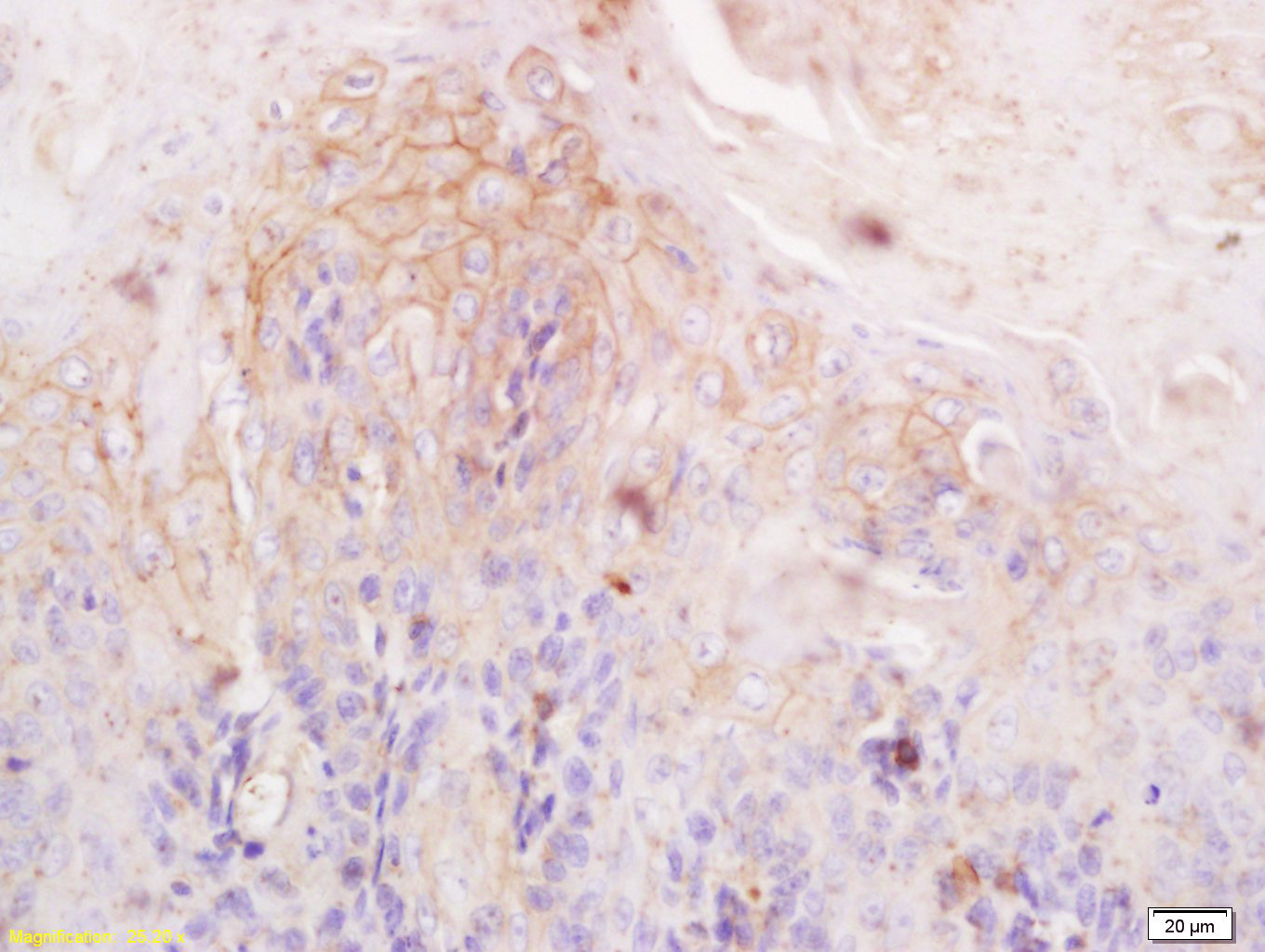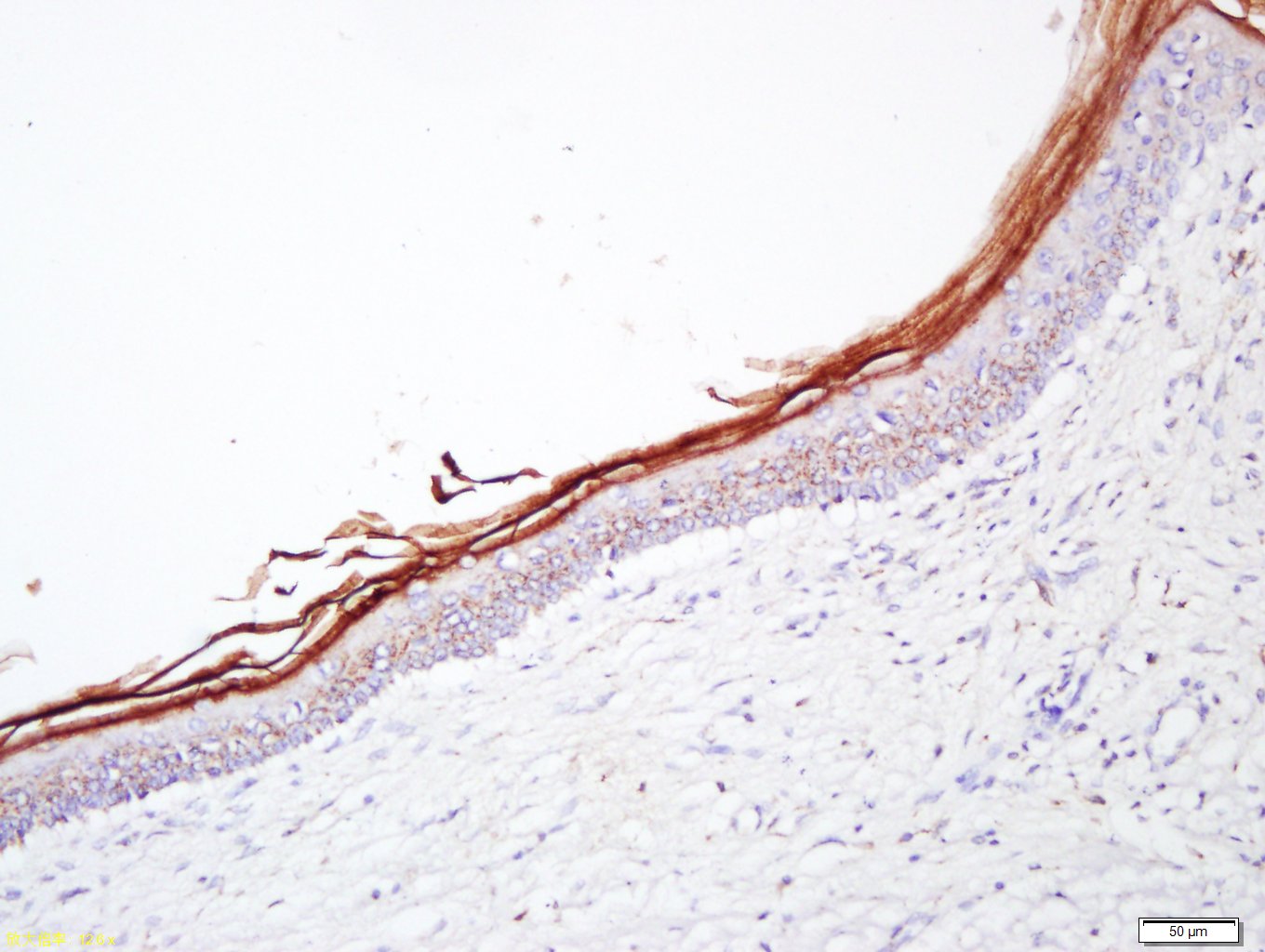Filaggrin Rabbit pAb
Filaggrin Rabbit pAb
- SPECIFICATION
- CITATIONS
- PROTOCOLS
- BACKGROUND

Application
| IHC-P, IHC-F, IF |
|---|---|
| Primary Accession | P20930 |
| Reactivity | Rat, Human |
| Host | Rabbit |
| Clonality | Polyclonal |
| Calculated MW | 447 KDa |
| Physical State | Liquid |
| Immunogen | KLH conjugated synthetic peptide derived from human Filaggrin |
| Epitope Specificity | 21-150/4061 |
| Isotype | IgG |
| Purity | affinity purified by Protein A |
| Buffer | 0.01M TBS (pH7.4) with 1% BSA, 0.02% Proclin300 and 50% Glycerol. |
| SIMILARITY | Belongs to the S100-fused protein family. Contains 2 EF-hand domains. Contains 23 filaggrin repeats. |
| Post-translational modifications | Filaggrin is initially synthesized as a large, insoluble, highly phosphorylated precursor containing many tandem copies of 324 AA, which are not separated by large linker sequences. During terminal differentiation it is dephosphorylated and proteolytically cleaved. The N-terminal of the mature protein is heterogeneous, and is blocked by the formation of pyroglutamate. Undergoes deimination of some arginine residues (citrullination). |
| DISEASE | Defects in FLG are the cause of ichthyosis vulgaris (VI) [MIM:146700]; also known as ichthyosis simplex. Ichthyosis vulgaris is the most common form of ichthyosis inherited as an autosomal dominant trait. It is characterized by palmar hyperlinearity, keratosis pilaris and a fine scale that is most prominent over the lower abdomen, arms, and legs. Ichthyosis vulgaris is characterized histologically by absent or reduced keratohyalin granules in the epidermis and mild hyperkeratosis. The disease can be associated with frequent asthma, eczema or hay fever. Defects in FLG are a cause of susceptibility to dermatitis atopic type 2 (ATOD2) [MIM:605803]. Atopic dermatitis is a complex, inflammatory disease with multiple alleles at several loci thought to be involved in the pathogenesis. It commonly begins in infancy or early childhood and is characterized by a chronic relapsing form of skin inflammation, a disturbance of epidermal barrier function that culminates in dry skin, and IgE-mediated sensitization to food and environmental allergens. It is manifested by lichenification, excoriation, and crusting, mainly on the flexural surfaces of the elbow and knee. |
| Important Note | This product as supplied is intended for research use only, not for use in human, therapeutic or diagnostic applications. |
| Gene ID | 2312 |
|---|---|
| Other Names | Filaggrin, FLG |
| Dilution | IHC-P=1:100-500,IHC-F=1:100-500,IF=1:100-500 |
| Storage | Store at -20 ℃ for one year. Avoid repeated freeze/thaw cycles. When reconstituted in sterile pH 7.4 0.01M PBS or diluent of antibody the antibody is stable for at least two weeks at 2-4 ℃. |
| Name | FLG |
|---|---|
| Function | Aggregates keratin intermediate filaments and promotes disulfide-bond formation among the intermediate filaments during terminal differentiation of mammalian epidermis. |
| Cellular Location | Cytoplasmic granule. Note=In the stratum granulosum of the epidermis, localized within keratohyalin granules (PubMed:1429717). In granular keratinocytes and in lower corneocytes, colocalizes with calpain-1/CAPN1 (PubMed:21531719). |
| Tissue Location | Expressed in skin, thymus, stomach, tonsils, testis, placenta, kidney, pancreas, mammary gland, bladder, thyroid, salivary gland and trachea, but not detected in heart, brain, liver, lung, bone marrow, small intestine, spleen, prostate, colon, or adrenal gland (PubMed:19384417). In the skin, mainly expressed in stratum granulosum of the epidermis (PubMed:1429717, PubMed:19384417) |

Thousands of laboratories across the world have published research that depended on the performance of antibodies from Abcepta to advance their research. Check out links to articles that cite our products in major peer-reviewed journals, organized by research category.
info@abcepta.com, and receive a free "I Love Antibodies" mug.
Provided below are standard protocols that you may find useful for product applications.
Background
This product as supplied is intended for research use only, not for use in human, therapeutic or diagnostic applications.
If you have used an Abcepta product and would like to share how it has performed, please click on the "Submit Review" button and provide the requested information. Our staff will examine and post your review and contact you if needed.
If you have any additional inquiries please email technical services at tech@abcepta.com.













 Foundational characteristics of cancer include proliferation, angiogenesis, migration, evasion of apoptosis, and cellular immortality. Find key markers for these cellular processes and antibodies to detect them.
Foundational characteristics of cancer include proliferation, angiogenesis, migration, evasion of apoptosis, and cellular immortality. Find key markers for these cellular processes and antibodies to detect them. The SUMOplot™ Analysis Program predicts and scores sumoylation sites in your protein. SUMOylation is a post-translational modification involved in various cellular processes, such as nuclear-cytosolic transport, transcriptional regulation, apoptosis, protein stability, response to stress, and progression through the cell cycle.
The SUMOplot™ Analysis Program predicts and scores sumoylation sites in your protein. SUMOylation is a post-translational modification involved in various cellular processes, such as nuclear-cytosolic transport, transcriptional regulation, apoptosis, protein stability, response to stress, and progression through the cell cycle. The Autophagy Receptor Motif Plotter predicts and scores autophagy receptor binding sites in your protein. Identifying proteins connected to this pathway is critical to understanding the role of autophagy in physiological as well as pathological processes such as development, differentiation, neurodegenerative diseases, stress, infection, and cancer.
The Autophagy Receptor Motif Plotter predicts and scores autophagy receptor binding sites in your protein. Identifying proteins connected to this pathway is critical to understanding the role of autophagy in physiological as well as pathological processes such as development, differentiation, neurodegenerative diseases, stress, infection, and cancer.



